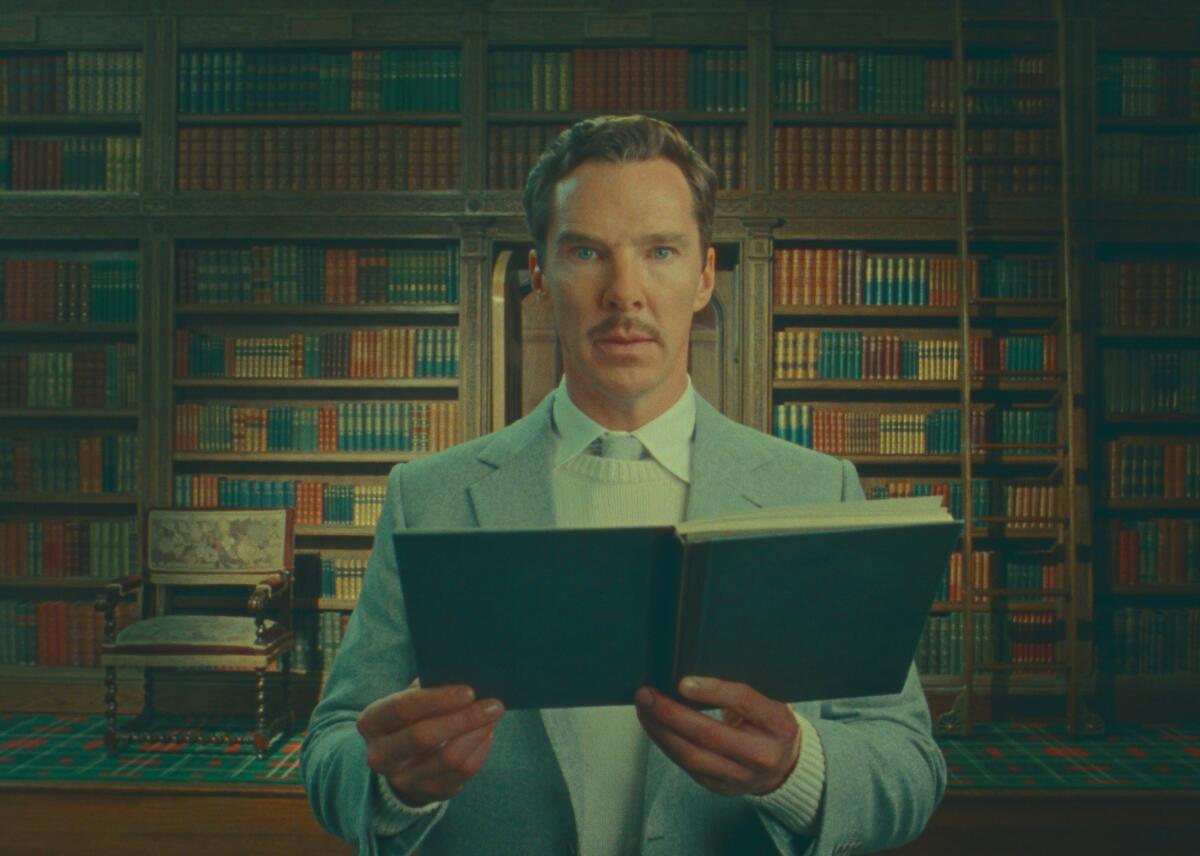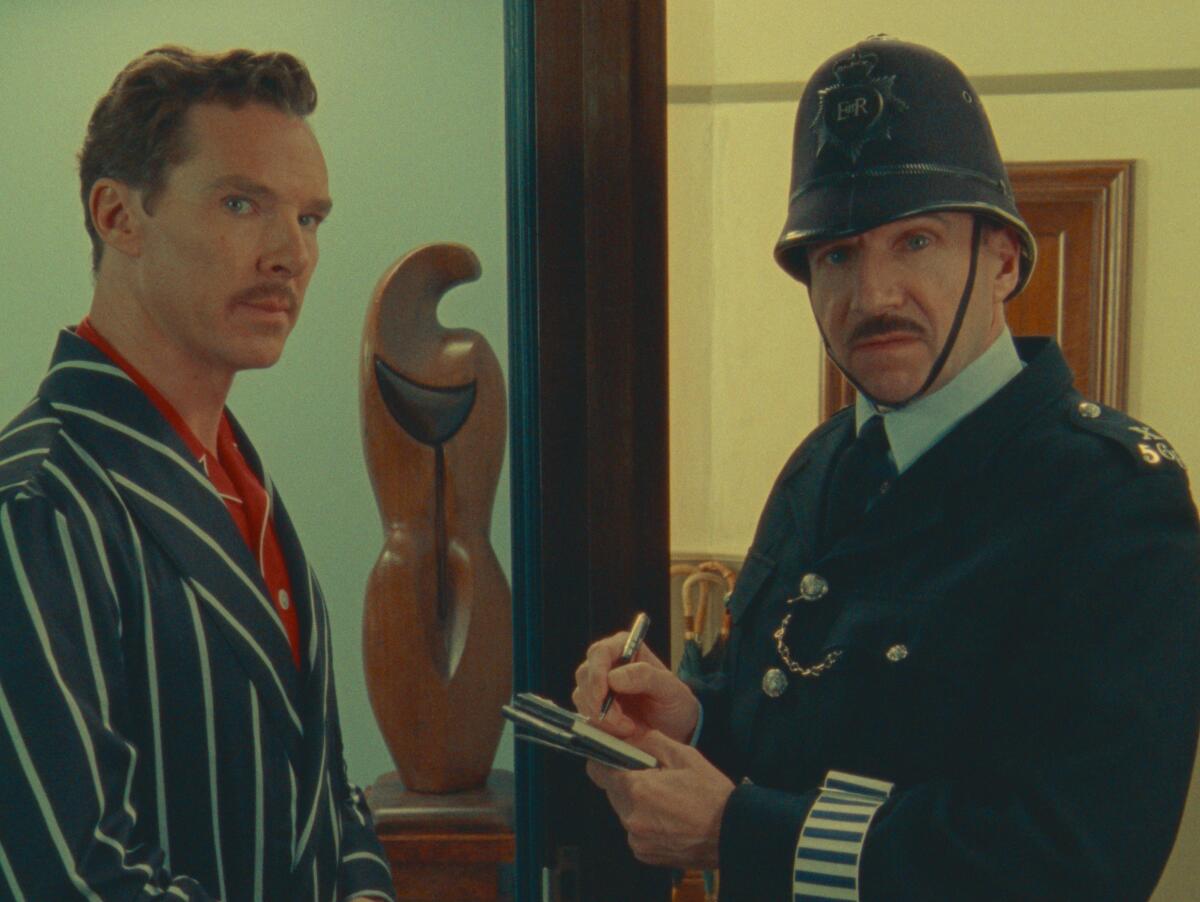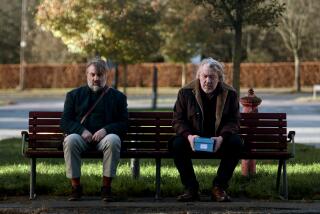Review: ‘The Wonderful Story of Henry Sugar’ is Wes Anderson at his sweetest

- Share via
Every wonderful story, Wes Anderson surely believes, is the work of a wonderful storyteller — or, at the very least, a storyteller worthy of the viewer’s time and the camera’s attention. And so it’s no surprise that “The Wonderful Story of Henry Sugar,” Anderson’s brilliant new adaptation of Roald Dahl’s 1977 tale of the same apt title, should open with Dahl himself. Played with thinning hair and a curmudgeonly sniff by Ralph Fiennes, the author sits in his Buckinghamshire writing hut (a fastidiously yellowed re-creation of Dahl’s real-life backyard workspace), pausing for a moment to tidy up his station before plunging us into a rapid-fire reading of his latest work.
This early, generous tribute to the author is, ironically, one of Anderson’s few departures from Dahl’s text. More ironically still, it’s the kind of fillip that readily identifies Anderson as this movie’s real auteur, in case you couldn’t guess already from the boxy frames, the symmetrical compositions, the harmoniously balanced colors and the deadpan directness with which the actors regularly address their speech to the camera. Few filmmakers are more consistently fascinated by the lives of writers, real and imagined, or more insistent that a literary creation cannot be considered apart from its creator. His recent movies have embraced this conceit as a matter of structural integrity: Think of the elaborate ’50s teleplay device of “Asteroid City,” the vintage magazine-style packaging of “The French Dispatch,” the concentrically layered narratives of “The Grand Budapest Hotel.”
One of the marvels of “The Wonderful Story of Henry Sugar,” a short film now available for streaming on Netflix, is that it so effortlessly distills these ongoing preoccupations while remaining utterly faithful to its source material. Not that fidelity is either a requirement or a virtue, as admirers of “Fantastic Mr. Fox,” Anderson’s stop-motion, feature-length Dahl-house of delights, will attest. “Henry Sugar” is a more modest affair, but also in some ways a subtler, more satisfying one. Running just 41 minutes, which is roughly the time it might take you to read the original story, it employs no fewer than four narrators across a span of more than six decades, all in service of a deftly multi-threaded yarn that has the elegance and concision of a well-executed magic trick.
Which is all too fitting, magic being one of the movie’s chief concerns. In short order, Fiennes’ on-screen Dahl conjures the character of Henry Sugar, an idly wealthy 1930s bachelor — and a real-life person, we’re told, hiding under a false name — played by a customarily dapper Benedict Cumberbatch. Stumbling on an odd manuscript in a friend’s library one rainy afternoon, Henry promptly passes the narrative baton to a Calcutta-based surgeon named Z.Z. Chatterjee (Dev Patel), who proceeds to relate an extraordinary encounter with scientific rigor. (Here and elsewhere, Anderson honors the idiosyncrasy of the storyteller: When Chatterjee punctuates his own dialogue with “I said” or describes actions right as they’re unfolding on-screen, he isn’t merely being whimsical or redundant; he’s trying to establish a verifiable record.)
It is Chatterjee who introduces us to Imdad Khan (Ben Kingsley), a wild-haired man of mystery who, we learn, has perfected the mysterious art of seeing without the use of his eyes. Even with his peepers sealed shut and tightly blindfolded, he can walk unassisted through a bustling hospital, dodging every obstacle in his path. Even more wondrous than this demonstration is Khan’s lengthy explication of how he came by this gift; suffice to say that it involves near-superhuman feats of visual focus and mental concentration, plus a firm conviction that “there are other ways of sending an image to the brain.”
Anderson, himself something of a master of counterintuitive alternatives, gives this idea its own fascinating cinematic correlative. In a film about transcending the limitations of one’s vision, he is careful not to show us everything, certain that our imaginations should do some of the visual lifting. And in a story about fantastical possibilities, he and his longtime collaborators, including the cinematographer Robert Yeoman and the production designer Adam Stockhausen, employ a beguilingly primitive form of movie magic. Anderson’s delight in all things analogue and antiquarian is in full flower here, as is his belief that real enchantment demands a measure of winkingly obvious artifice: The more we can see the seams, the grander the illusion.

And so when Henry moves from one room of a house to another, or steps out onto a bustling casino floor, the building moves with him, realigning itself in a flurry of shifting walls. Some of those walls are pushed aside by stagehands, who pop up regularly to reconfigure the scenery, hand off props and, in one delightful gag, reposition Khan himself on the opposite side of the frame. Henry goes on a drive assisted by old-school rear projection. Khan’s miraculous blindfolded walk is filmed almost entirely from behind — a rudimentary solution to a technical problem that nonetheless makes you wonder, as no CGI-dependent sequence ever would, exactly how it might have been pulled off. The four splendid principal actors cycle through multiple roles, as does a slyly funny Richard Ayoade, who first pops up as one of Chatterjee’s medical colleagues. And when characters levitate off the ground, as they do from time to time, the effect is managed by — well, see for yourself. Some tricks shouldn’t be spoiled.
All this might sound like a typically fastidious exercise in Andersonian ornateness, a return to a lavishly appointed bubble-world that turns the cinematic frame into a proscenium arch (emphasis on the arch). But seldom has the director’s formal cleverness felt so pure and purposeful, so vitally linked to the tale he’s telling. His movies have always proposed — sometimes ingeniously, sometimes exhaustingly, always sincerely — that we might benefit from looking at the world from a fresh vantage. And so it is with “The Wonderful Story of Henry Sugar,” in which a revolutionary new way of seeing holds the key to an altogether deeper transformation.
Henry, realizing that Khan’s secret could make him an even wealthier man than he already is, sets out to master its mysteries — only to discover, to his surprise and delight, that those mysteries have also had their way with him. Deception, he realizes, can be used to magnanimous ends, and magic, this movie amply proves, can be a force for good.
'The Wonderful Story of Henry Sugar'
Rating: PG, for smoking
Running time: 41 minutes
Playing: Streaming on Netflix
More to Read
Only good movies
Get the Indie Focus newsletter, Mark Olsen's weekly guide to the world of cinema.
You may occasionally receive promotional content from the Los Angeles Times.











